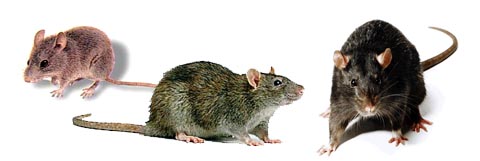Rodents

Rodents: Info, Control & Prevention
Let’s face it – when most of us first come in contact with a rodent, the last thing we want to do is stare at the rodent long enough to determine what kind it is, much less study the habits of the rodent. So it’s important to hire a qualified rodent control professional to help determine the kinds of rodents you may have in your home, as well as what you can do to get rid of them.
House Mice:
The most common rodent pests in most areas of the world, house mice are amazingly resilient rodents. House mice can breed fast and at any time of the year, and they can adapt to changing conditions quickly. House mice prefer to live in buildings, but they can also survive outdoors. Although they don’t pose a serious threat, droplets of urine from house mice can cause allergies in children, and house mice can attract lice, ticks, mites, and fleas into your home. Therefore, house mice control is important. For house mice prevention, make sure all holes leading into your house are sealed (or are no less than the diameter of a pencil) and install gutters that will channel water away from your home. For additional house mice information and specific tips on house mice prevention and house mice control, check out theNational Pest Management Association fact sheet on House Mice.
Norway Rats:
Long and slender, the Norway rat can slip into a home through a hole the size of a quarter. Norway rats have smaller eyes and ears and shorter tails, and they can be brown, gray, or black. Norway rats can live outside in fields, farm lands, and woodpiles, but they often enter houses in the fall when the temperatures drop and outside food sources dwindle. Norway rats are harmful in that they can chew through wiring, and they also spread numerous diseases; therefore, Norway rat control is important. For Norway rat prevention, keep moisture and wood piles away from you house, remove other debris, and make sure all holes larger than 1/4″ in diameter are sealed. For additional Norway rat information and specific tips on Norway rat prevention and Norway rat control, check out the National Pest Management Association fact sheet on Norway Rats.
Roof Rats:
The large, long 16″ roof rat got its name from its love of high parts of buildings (although it also likes the underside of structures). Roof rats are color blind and they have poor vision overall, but they make up for their weak sight with strong senses of hearing, touch, smell and taste. Roof rats can squeeze into a building through a space only a half an inch wide and start causing rodent damage. Roof rats received a particularly bad name in history after they helped spread the deadly bubonic plague. Today, roof rats support many ectoparasites and they urinate on food; therefore, roof rat control is important. For roof rat prevention, seal up any holes in your home larger than a quarter and remove any sources of harborage and moisture. For additional roof rat information and specific tips on roof rat prevention and roof rat control, check out the National Pest Management Association fact sheet on Roof Rats.
Click On The Pest Category To Learn More.
| Bedbug Guide | House Centipedes |
| Carpenter Ants | Mosquitoes |
| Clothes Moths | Roaches |
| Fly Facts | Ants vs Termites |
| Little Black Ant | Termites |
| Odorous House Ant | House Flies |
| Fruit Flies | Rodents |






